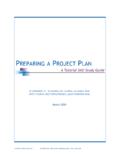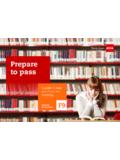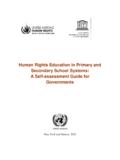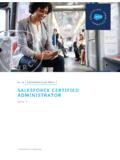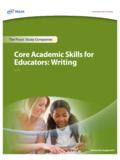Transcription of Behavioural, emotional and social difficulties – Self ...
1 Special educational needs and/or disabilitiesTraining toolkitFor PGCE traineesBehavioural, emotional and social needs behavioural , emotional and social difficulties self - study task 92 Session 3 Overview of the inclusion statementDevelopment and diversity2 self - study task 9 behavioural , emotional and social difficulties behavioural , emotional and social needsIntroduction to the self - study tasksThese self - study tasks are designed to help trainee teachers on PGCE courses learn more about teaching pupils with special educational needs (SEN) and/or disabilities. They can be used as stand-alone activities or to supplement and extend taught sessions on SEN and disability provided by the school or local are 17 self - study tasks in all. Each task will take about two hours to complete, excluding practical Child MattersSST1 Inclusion and Every Child Matters SST2 SEN and disability legislationSST3 English as an additional language and SENS S T4 Children s needs and developmentSST5 ICT and SENC ognition and learningSST6 Moderate learning difficultiesSST7 Dyslexia and specific learning difficultiesSST8 Working memory behavioural , emotional and social needsSST9 behavioural , emotional and social difficultiesCommunication and interactionSST10 Speech.
2 Language and communication needsS S T11 Autistic spectrum disordersPhysical and sensory impairmentSST12 Visual impairment SST13 Hearing impairmentSST14 HandwritingSST15 Developmental coordination disorder/dyspraxiaWorking in partnershipSST16 Working with colleagues in schoolSST17 Working with parents/carers and other professionals 3 Session 3 Overview of the inclusion statementDevelopment and diversity3 self - study task 9 behavioural , emotional and social difficulties behavioural , emotional and social needsHow to use the materialsThis is an online resource. Some of the tasks are for you to do on your own; others are particularly suitable to do working with a some of the tasks ask you to record information you need to print out the relevant material first. Other tasks may involve using the internet, which gives you access to rich sources of information about SEN and disability and online forums for additional task includes the following elements:the professional standards addressed "learning outcomes "an opportunity to explore the concepts, definitions and research findings most relevant "to the topicideas for implementing the national curriculum inclusion statement in relation to the topic, "including target setting, practical strategies, the role of additional adults and pupil groupingpractical activities including action research, child study and class observation "resources including books and websites "an opportunity to evaluate your progress against the outcomes and plan your next steps.
3 "A useful resource to support your studies is Implementing the Disability Discrimination Act in Schools and Early Years Settings (DfES, 2006). It is available free to all schools and there should be a copy in your training institution or school. (If you haven t got a copy, you can order one using the link.)It should be read in conjunction with Promoting Disability Equality in Schools (DfES, 2006) which you can view, download or order by following the link. Evidence and sources of informationAs you work through these self - study tasks, try to keep a critical and evaluative attitude. Much of the understanding we have of what works, or doesn t work, in relation to meeting the needs of pupils with SEN and/or disabilities has not been fully :many interventions suggested for one group of pupils with SEN and/or disabilities will often "benefit other groups of pupils, including those without SEN and/or disabilitiesthe quickest way to find out what to do is often to ask the pupil or their parent/carer what they "think reviews of what works in relation to literacy and mathematics for pupils with SEN and/or disabilities, which has been investigated in some depth, are available at.
4 Task 9 behavioural , emotional and social difficultiesBehavioural, emotional and social needsSelf- study task 9 behavioural , emotional and social difficulties Professional standards addressedQ10 Have a knowledge and understanding of a range of teaching, learning and behaviour management strategies and know how to use and adapt them, including how to personalise learning and provide opportunities for all learners to achieve their lessons and sequences of lessons across the age and ability range for which they are trained in which they: (a) use a range of teaching strategies and resources, including e-learning, taking practical account of diversity and promoting equality and inclusion(b) build on prior knowledge, develop concepts and processes, enable learners to apply new knowledge, understanding and skills and meet learning objectives(c) adapt their language to suit the learners they teach, introducing new ideas and concepts clearly, and using explanations, questions, discussions and plenaries effectively (d)
5 Demonstrate the ability to manage the learning of individuals, groups and whole classes, modifying their teaching to suit the stage of the a purposeful and safe learning environment conducive to learning and identify opportunities for learners to learn in out-of-school a clear framework for classroom discipline to manage learners behaviour constructively and promote their self -control and outcomesYou will:be familiar with the terminology used to describe behavioural , emotional and social " difficulties (BESD)understand that these difficulties have many different causes "understand that pupils with BESD may have gaps in their social , emotional and " behavioural skills know how to build work on these skills into everyday teaching, and "be familiar with some of the teaching approaches and strategies that are appropriate "for pupils with 3 Overview of the inclusion statementDevelopment and diversity5 self - study task 9 behavioural , emotional and social difficulties behavioural , emotional and social needsActivities TimingsActivity 1 The nature of behavioural , emotional and social difficulties (BESD) 15 minutesActivity 2 Understanding behaviour.
6 An ABC model 20 minutesActivity 3 Understanding behaviour: children s concerns and needs 15 minutesActivity 4 Choosing appropriate learning objectives 20 minutesActivity 5 Choosing appropriate teaching styles and approaches 15 minutesActivity 6 Removing barriers to learning for pupils with BESD 10 minutesActivity 7 Points for action 15 minutesAppendix Suggested answers and solutions5 self - study task 9 behavioural , emotional and social difficultiesBehavioural, emotional and social needsPrior learningThis self - study unit is not about behaviour management in general. It is about meeting the needs of pupils with BESD. Before working through this task, you need to have a secure understanding of the principles of behaviour example, you will need to:understand how to create a learning environment that promotes positive behaviour "know about the 4Rs framework (rights, responsibilities, rules and routines) and how to "use it to set expectations for behaviour in your classesknow how to use choice and consequences effectively, and "understand the importance of building positive relationships.
7 "You may already have had training on general behaviour management as part of your PGCE programme. self - study materials are also available on the web to support you in learning about this. Useful links include: National Strategies resources on social and emotional Aspects of Learning (SEAL) " practical tips and downloadable booklet on ATL s site " materials and video resources at Behaviour4 Learning " 3 Overview of the inclusion statementDevelopment and diversity6 self - study task 9 behavioural , emotional and social difficulties behavioural , emotional and social needsActivity 1 The nature of behavioural , emotional and social difficulties (BESD) Approximate timing: 15 minutesThis activity will help you become familiar with the terminology used to describe BESD and to understand that such difficulties have multiple studyYou will need a pad of sticky notes for this the case study of Norman study : NormanNorman is 11.
8 He lives with his mother and older brother. His parents split up when he was six years old and he sees his father only occasionally. His mother finds him hard to manage. She describes him as always on the go, restless and argumentative . The only thing that keeps him occupied is playing video games, often violent ones. He has begun to go around with a group of older boys on his estate who are often in trouble. At school he rarely sits still for long, talks incessantly, calls out inappropriately and often gets into arguments with other pupils, for example over equipment or who sits class he works best on practical activities. He is achieving below the expectations for his age in most subjects, and he has quite significant literacy difficulties . In mathematics, he has strengths in shape and space, and data handling, but struggles with calculations.
9 He considers himself to b e s t u pid .When he was younger, his teachers found him hard work, but likeable. He s always so sorry for the things he does wrong , one teacher said, even if he then just goes and does them again . She felt his difficulties were the result of having had a number of temporary teachers at different times in his schooling. His school had a difficult Ofsted inspection which led to a number of staff current teachers are driven to distraction by his behaviour and are feeling increasingly negative about minsQuickly write down reasons one per sticky note why Norman might be behaving as he is. Then group your sticky notes into categories that make sense to you. Examples might be home factors, social and cultural factors, school factors and factors in the young person himself (such as temperament or a psychiatric condition).
10 Reflect on how you would describe Norman. For example, do you see him as having mental health problems , having SEN or as a product of a particular social setting?Now read the notes on the next two pages, which describe the different terminologies that might be used in relation to pupils who exhibit difficult behaviour. The term chosen often depends on whether the cause of the behaviour is seen as medical, educational or 3 Overview of the inclusion statementDevelopment and diversity7 self - study task 9 behavioural , emotional and social difficulties behavioural , emotional and social needsTerminologyBehavioural, emotional and social difficulties (BESD)Pupils may be described as having a type of SEN called BESD when their behaviour interferes with their own learning or that of others.











